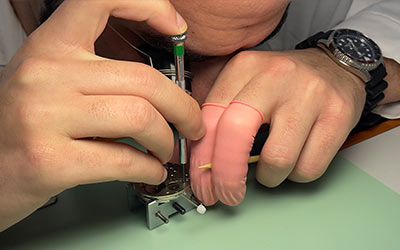The Art of Precision Meets Creativity
Watchmaking is more than just a practical skill or profession - it is an art that blends precision, innovation, and aesthetics.
From traditional mechanical movements to modern technologies, watchmaking maintains its timeless appeal while adapting to the demands of the contemporary world. In recent years, the industry has been regaining ground, as its significance is recognized in combination with other arts and professions, offering promising career opportunities.
Learning the Craft of Watchmaking
Mastering the art of watchmaking requires dedication, patience, and attention to detail. Studies in this field involve both theoretical understanding of a watch’s mechanical function and hands-on training in manufacturing, maintenance, and repair. Specialized schools and educational programs worldwide provide comprehensive knowledge, while apprentices often work alongside experienced watchmakers to gain practical experience.
Collaboration with Other Arts
Watchmaking does not exist in isolation; rather, it often intersects with other artistic fields, resulting in unique creations. For example:
- Jewelry Design & Goldsmithing: Watch dials and cases are often adorned with precious stones or intricate engravings, requiring the expertise of master jewelers.
- Graphic Design & Artistic Craftsmanship: Modern watch collections frequently feature artistic elements that create striking dials, reflecting contemporary aesthetics.
- Engineering & Robotics: The development of new mechanisms and automatic functions in watches often requires collaboration with engineers and robotics specialists.
Career Prospects
The art of watchmaking offers a variety of career paths. One can pursue a career as an independent craftsman, creating unique, handmade watches. Alternatively, working for renowned watch brands provides access to cutting-edge technology and global recognition. The restoration and repair of antique watches is also a highly specialized and in-demand field.
Moreover, watchmaking opens doors for interdisciplinary collaborations. Craftsmen may work alongside artists, architects, or even artificial intelligence specialists to create groundbreaking designs and innovative functionalities.
The Importance of Preserving Tradition
Although technology has influenced every aspect of modern life, watchmaking remains deeply rooted in tradition. Preserving traditional techniques is both a challenge and an honor for artisans who strive to pass down their knowledge to new generations. This connection between past and future enhances the uniqueness of the profession.
Conclusion
Watchmaking, as both an art and a profession, serves as a unique platform that bridges tradition with innovation, offering endless possibilities for creativity and growth. Its collaboration with other artistic fields and professions is not just a trend but a necessity, ensuring the industry’s evolution and longevity. For those seeking a career that combines skill, creativity, and prestige, watchmaking is an exceptional choice.

